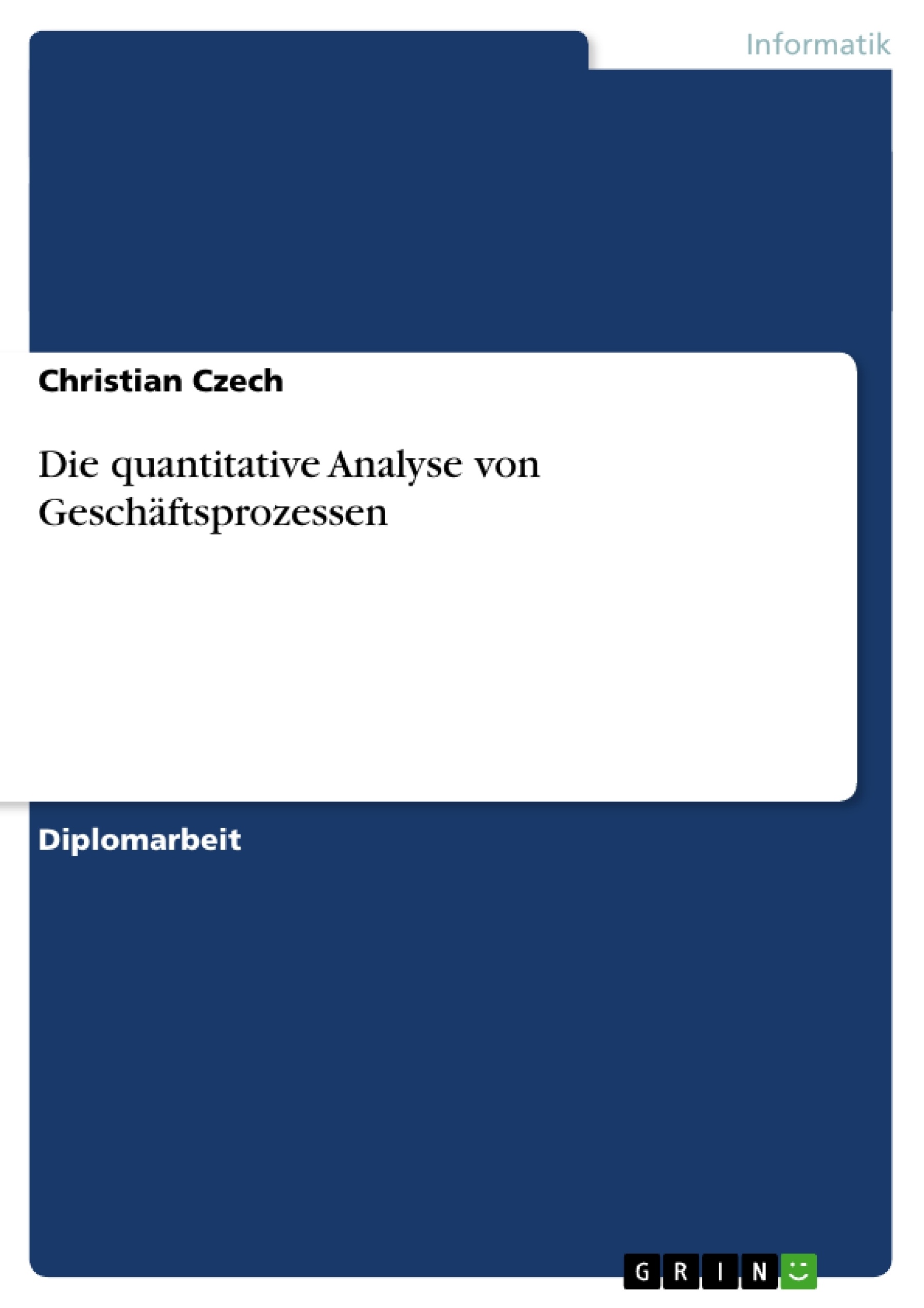Die Gestaltung und Optimierung von Geschäftsprozessen ist ein aktuelles Thema. Besonders der komplexe Bereich des Workflow-Managements tritt immer weiter in den Fokus der strategischen Betrachtung des Unternehmens im Spannungsfeld zwischen Marktanforderungen und Konkurrenzdruck.
Ein Gesichtspunkt dabei ist die Modellierung der Geschäftsprozesse. Damit wird aber nur der nächste Schritt eingeleitet, nämlich das neue Modell auf semantische und formale Korrektheit hin zu überprüfen und vor allem Effizienzmessungen durchzuführen.
Gegenstand dieser Diplomarbeit soll die quantitative Analyse der Geschäftsprozesse sein. Sie beschäftigt sich mit den Fragen der Effizienz der Prozesse und ihrer Simulation. Der letzte Punkt erlangt besondere Bedeutung durch die Risikosenkung bei der Implementierung neuer Prozesse in eine bestehende Organisation.
Mit einem Top-Down-Ansatz wird zunächst die Modellierung von Geschäftsprozessen besprochen und hierbei die besondere Eignung von Petri-Netzen als Modellierungssprache zur Analyse herausgestellt. Anschließend wird auf die Analyse allgemein und dann speziell auf die quantitative Analyse eingegangen.
Schwerpunkt der Arbeit wird die Darstellung der Performance-Analyse zur Effizienzmessung und der Simulation als Mittel zur Erkenntnisgewinnung sein.
Die betrachteten Algorithmen sollen für das Modellierungstool WoPeD (Workflow Petri Net Designer)1 in Java implementiert werden. Dabei handelt es sich um Open-Source-Software, die an der Berufsakademie Karlsruhe entwickelt wurde und zur Modellierung und Analyse von Geschäftsprozessen auf Basis von Workflow-Netzen insbesondere im akademischen Bereich genutzt wird.
Abschließend werden die Ergebnisse der Arbeit kritisch beurteilt und ein Ausblick auf weitere Entwicklungsmöglichkeiten gegeben.
Inhaltsverzeichnis
- 1 Einleitung
- 2 Geschäftsprozessmodelle und ihre Analyse
- 2.1 Modelle von Geschäftsprozessen
- 2.1.1 Modellierung
- 2.1.2 Modellelemente von Geschäftsprozessen
- 2.1.3 Sprachen zur Modellierung.
- 2.2 Analyse von Geschäftsprozessmodellen
- 2.2.1 Zum Begriff der Analyse.
- 2.2.2 Quantitative Analysemethoden
- 2.2.3 Quantitative Analyse von Geschäftsprozessen
- 2.1 Modelle von Geschäftsprozessen
- 3 Kapazitätsplanung
- 4 Ereignisdiskrete Simulation
- 5 Implementierung in Java
- 5.1 Algorithmus zur Kapazitätsanalyse
- 5.2 Algorithmus zur Simulation
- 6 Bewertung und Ausblick
Zielsetzung und Themenschwerpunkte
Die Diplomarbeit zielt darauf ab, die quantitative Analyse von Geschäftsprozessen zu untersuchen und ein Framework für die Bewertung und Optimierung von Geschäftsprozessen zu entwickeln. Die Arbeit befasst sich insbesondere mit der Anwendung von Simulationsmethoden zur Kapazitätsanalyse und Prozessoptimierung.
- Modellierung und Analyse von Geschäftsprozessen
- Quantitative Analysemethoden für Geschäftsprozesse
- Kapazitätsplanung und -simulation
- Implementierung von Algorithmen in Java
- Bewertung und Ausblick auf zukünftige Anwendungen
Zusammenfassung der Kapitel
- Kapitel 1: Einleitung: Diese Einleitung stellt das Thema der Diplomarbeit vor und beschreibt die Motivation und den Umfang der Arbeit.
- Kapitel 2: Geschäftsprozessmodelle und ihre Analyse: Dieses Kapitel behandelt verschiedene Modelle von Geschäftsprozessen, ihre Modellierungselemente und Sprachen zur Modellierung. Es beleuchtet außerdem die Analyse von Geschäftsprozessmodellen, insbesondere quantitative Analysemethoden und ihre Anwendung auf Geschäftsprozesse.
- Kapitel 3: Kapazitätsplanung: Dieses Kapitel fokussiert auf die Kapazitätsplanung und die Bedeutung von Kapazitätsanalysen für die Optimierung von Geschäftsprozessen.
- Kapitel 4: Ereignisdiskrete Simulation: Dieses Kapitel erläutert das Konzept der ereignisdiskreten Simulation und deren Einsatzmöglichkeiten für die Analyse von Geschäftsprozessen.
- Kapitel 5: Implementierung in Java: Dieses Kapitel beschreibt die Implementierung eines Algorithmus zur Kapazitätsanalyse und eines Algorithmus zur Simulation in Java.
Schlüsselwörter
Geschäftsprozessmodellierung, quantitative Analyse, Kapazitätsplanung, ereignisdiskrete Simulation, Java, Algorithmen, Optimierung.
- Quote paper
- Christian Czech (Author), 2007, Die quantitative Analyse von Geschäftsprozessen, Munich, GRIN Verlag, https://www.grin.com/document/81707




